On November 10…
“Rather than saying, ‘I can’t do this,’ Sesame Street encourages us to say, ‘I can’t do this… yet!’ That one word changes everything. It emphasizes that your capability isn’t fixed. It highlights the reality that our brain is like a muscle.”
~Sal Khan
Founder, Khan Academy
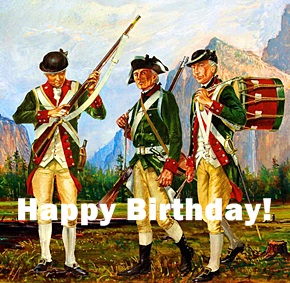
1775 – The Continental Congress passed a resolution stating that “two Battalions of Marines be raised” for service as landing forces for the recently formed Continental Navy.
The resolution, drafted by future U.S. president John Adams, created the Continental Marines and is now observed as the birth date of the United States Marine Corps.
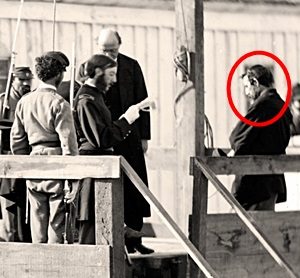
1865 – Henry Wirz, the commander of Andersonville prison in Georgia, was hanged in the courtyard of the Old Capitol Prison on what is now the site of the U.S. Supreme Court.
Wirz had been found guilty of the murder of soldiers incarcerated at Andersonville during the Civil War. While both sides incarcerated prisoners under horrible conditions, Andersonville deserves special mention for the inhumane circumstances under which its inmates were kept.
The prison was designed to hold 10,000 men but the Confederates had packed it with more than 31,000 inmates by August 1864.
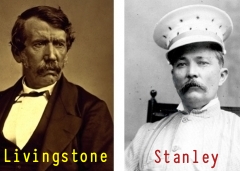
1871 – Henry Stanley found the missing Scotsman, David Livingstone.
Livingstone, an explorer and missionary, had been missing for two years. No white man had seen him in six years.
Stanley’s search for Dr. Livingstone ended at Ujiji, Africa.
He greeted the doctor with, “Dr. Livingstone, I presume?”
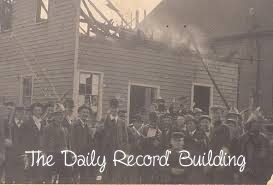
1898 – White supremacists, marching in a procession 2,000 strong, battled black citizens in Wilmington, NC in an explosion of violence two days after a part-black fusion slate won elections in Wilmington, then the state’s largest city and with a black majority.
The white mob, led by former Congressman Alfred Wardell, attacked the city’s black newspaper, Daily Record, burning down the building. They ran officials and community leaders out of the city, and killed many blacks in widespread attacks.
During the riot, members of Alfred Moore Waddell’s Committee of Twenty-Five worked to facilitate a coup d’etat to overthrow the newly Republican mayor and Board of Aldermen. By 4:00 P.M., the elected officials were resigning and being replaced by men selected by the Committee of Twenty-Five.
The newly placed Board of Aldermen elected Waddell mayor; a position he held until 1905.
The event – the only instance of a municipal government being overthrown in U.S. history – was nothing less than a revolution against interracial democracy.
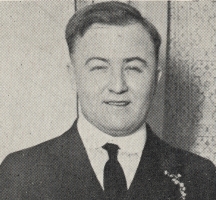
1924 – Dion O’Banion, leader of the North Side Gang, was assassinated in his flower shop by members of Johnny Torrio’s gang, sparking the bloody gang war of the 1920s in Chicago.
That war culminated in the killing of seven North Side gang members in the St. Valentine’s Day massacre in 1929.
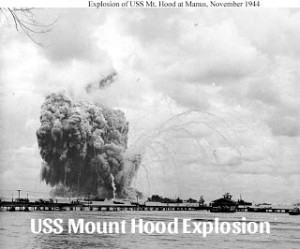
1944 – The USS Mount Hood, an ammunition ship for The U.S. Navy, exploded with an estimated 3,800 tons of ordnance material on board. No human remains were recovered of the 350 men aboard the ship or small boats loading alongside.

The concussion and metal fragments hurled from the ship also caused casualties and damage to ships and small craft within 2,000 yards. The repair ship Mindanao, which was broadside-on to the blast, was the most seriously damaged. All personnel topside on Mindanao were killed outright, and dozens of men were killed or wounded below decks as numerous heavy fragments from Mount Hood penetrated the side plating.
A total of Mindanao‘s 82 crew members died. The damage to other vessels required more than 100,000 man-hours to repair, while 22 small boats and landing craft were sunk, destroyed, or damaged beyond repair.
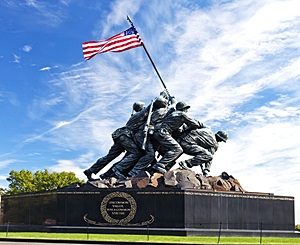
1954 – The Marine Corps War Memorial (better known as the Iwo Jima Memorial) was dedicated to all personnel of the United States Marine Corps who had died in the defense of the United States since 1775.
The memorial – based on the photograph taken by Associated Press photographer Joe Rosenthal – features the statues of the six servicemen who raised the second U.S. flag on Mount Suribachi during the Battle of Iwo Jima in World War II.
Thirty-two foot high figures are shown raising a 60-foot bronze flagpole. The flag at the top of the pole flies at full mast 24 hours a day, 365 days a year by presidential proclamation in 1961.

1964 – Jimmie Dodd (best known as the host of The Mickey Mouse Club as well as the writer of its well-known theme song, died of cancer at the age of 54.

1969 – Sesame Street, a pioneering TV show that would teach generations of young children the alphabet and how to count, made its broadcast debut.
The show was the brainchild of Joan Ganz Cooney, a former documentary producer for public television. Cooney’s goal was to create programming for preschoolers that was both entertaining and educational. She also wanted to use TV as a way to help underprivileged 3- to 5- year-olds prepare for kindergarten.
From the show’s inception, one of its most-loved aspects has been a family of puppets known as Muppets.
Puppeteer Jim Henson created a cast of characters who became Sesame Street institutions, including Bert and Ernie, The Count, Cookie Monster, Oscar the Grouch, Grover and Big Bird.
Sesame Street went on to become the most widely viewed children’s program in the world, airing in more than 140 countries.
As of 2019, Sesame Street has won 189 Emmy Awards and 11 Grammy Awards, more than any other children’s show.

1972 – Southern Airways Flight 49, en route from Memphis to Miami, was hijacked during a stop in Birmingham, Alabama.
Three hijackers boarded the plane armed with handguns and hand grenades. At gunpoint, they took the airplane, the plane’s crew of four, and 27 passengers to nine American cities and Toronto, Canada before eventually landing in Havana, Cuba.
During the long flight the hijackers threatened to crash the plane into the Oak Ridge nuclear facilities in Tennessee, insisted on talking with President Richard Nixon, and demanded a ransom of $10 million.
Eventually the pilot talked the hijackers into settling for the $2 million. Upon landing in Havana, Cuban authorities arrested the hijackers and, after a brief delay, sent the plane, passengers, and crew back to the United States.

1973 – David “Stringbean” Akeman and his wife were murdered by burglars at their rural Tennessee home.
Akeman was a musician and comedian best known for his role on the television show Hee Haw, and as a member of the Grand Ole Opry.
John A. Brown and Marvin Douglas Brown, two 23-year old cousins, were convicted for the murders. Marvin Brown died of natural causes in 2003. John Brown was sentenced to 198 years in prison but was granted parole after serving 41 years.

1975 – The SS Edmund Fitzgerald sank 17 miles from the entrance to Whitefish Bay on Lake Superior, taking all 29 crew members with her.
Just after 7 p.m. on November 10, the Fitzgerald made its last radio transmission. Presumably, the ship, which was taking on water, was forced lower and lower into the water until its bow pitched down into the lake and the vessel was unable to recover.
The ship now rests 530 feet underwater, broken in two sections.
The tragedy later became the subject of Gordon Lightfoot’s hit song.
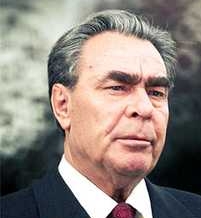
1982 – After 18 years as general secretary of the Soviet Communist Party, Leonid Brezhnev died of a heart attack.
His death signaled the end of a period of Soviet history marked by both stability and stagnation. During Brezhnev’s reign political repression took on more and more ominous overtones.
Dissidents such as Aleksandr Solzhenitsyn and Andrei Sakharov were harassed and sentenced to internal exile.
Brezhnev’s program to bring the Soviet military to parity with the United States drove the Russian economy to the breaking point.
Cowboy Factoid: When Brezhnev visited the White House in 1973, actor Chuck Connors gave the Soviet leader two Colt .45 six-shooters and a cowboy hat. Brezhnev, a fan of Westerns, was so overjoyed by the gift that he picked up the 6-foot-6 actor and lifted him into the air.
Which makes the timing of our next event a little strange…
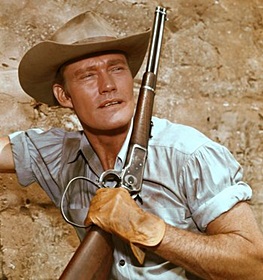
1992 –Actor Chuck Connors died at the age of 71 of pneumonia stemming from lung cancer.
He was best known for his five-year role as Lucas McCain in the television series The Rifleman.
Before his acting career, Connors was one of only 12 athletes in the history of American professional sports to have played both Major League Baseball (Brooklyn Dodgers and Chicago Cubs) and the National Basketball Association (Boston Celtics).
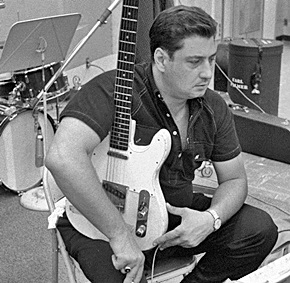
1997 – Tommy Tedesco (“Wrecking Crew” session guitarist) died of lung cancer at the age of 67.
Tedesco played on hit songs with The Beach Boys, The Association, Ronettes, Everly Brothers, Sam Cooke, Elvis Presley, Frank Sinatra, Joan Baez, Cher, and literally thousands more.
Tedesco’s TV Factoid: Called “the most recorded guitarist in history” by Guitar Player magazine, Tedesco was the featured player on several television theme songs you might recall, including Bonanza, Green Acres, M*A*S*H, Batman and The Twilight Zone.

2001 – In the wake of the September 11 terrorist attacks on the World Trade Center in New York City and The Pentagon in Washington, D.C., President George W. Bush addressed the United Nations to ask for the international community’s help in combating terrorism around the world.
He also pledged to take the fight against terrorism to any place where terrorists were harbored.

2006 – Actor Jack Palance died of natural causes at the age of 87.
He won an Emmy Award for Best Performance by An Actor for his role in Requiem For A Heavyweight, and was nominated for three Academy Awards for Best Supporting Actor; Sudden Fear, Shane and City Slickers, winning in 1991 for the latter.

2009 – John Allen Muhammad, mastermind of the 2002 sniper attacks that killed 10 in the Washington, D.C. region, was executed by lethal injection.
Lee Boyd Malvo, his accomplice in the murders, was sentenced to six consecutive life sentences without possibility of parole and is incarcerated at Red Onion State Prison in Virginia.
Compiled by Ray Lemire ©2019 RayLemire.com / Streamingoldies.com. All Rights Reserved.
